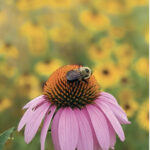 My friend, Kelly, described her difficult childhood this way: “I didn’t live in the kid bubble. I understood the concept of need—that no matter what it was, I couldn’t have it.”
My friend, Kelly, described her difficult childhood this way: “I didn’t live in the kid bubble. I understood the concept of need—that no matter what it was, I couldn’t have it.”
She lived in an environment of domestic violence and poverty. When Kelly was 14, her sister ran away, and it would be years before she saw her again. One month later, her father left, deepening the family’s financial hardship.
There’s a word to describe Kelly’s continual childhood adversity—trauma. And there’s an acronym to describe the incidents that made it up— Adverse Childhood Experiences (ACEs).
I was unfamiliar with ACEs when I entered John Harris High School several months ago to view the documentary, “Resilience: The Biology of Stress & the Science of Hope,” hosted by Communities in Schools of Pennsylvania, an affiliate of the largest dropout prevention organization in the United States, and Mission Central, which helps people overcome traumatic situations.
I knew that stress affected children’s learning and behavior, but not much about why that happens. I also considered these behaviors exclusively a mental health issue and lacked the knowledge to connect the dots between ACEs and long-term physical and emotional outcomes in children. Over the coming months, I learned a lot about children and trauma.
Just Surviving
The idea of ACEs originated from a 1995-97 Kaiser Permanente study.
About 17,000 patients completed a survey about their upbringing and present health status. Ten questions were categorized into three types of events: abuse directed toward the participant; neglect, directly involving the participant; and household challenges, which included domestic violence in the home, substance abuse, divorce or imprisonment of a family member.
Each event was given a score of one. Participants’ ACE scores were compared to their present health status. The results showed that the higher the ACE score, the increased likelihood of bad health outcomes such as alcoholism, drug use, depression, suicide attempts and cancer, among others.
Kelly scored an eight.
The study surprised me. I had never considered that terrible events could influence a person’s physical health. But what I found even more compelling were the mechanisms at work in the body during trauma that cause these outcomes.
Trauma, also known as toxic stress, affects children physiologically.
“It’s not just that they are hungry, not just that they don’t have a place to live,” said Ryan Riley, president and state director of Communities in Schools PA. “It’s toxic stress, causing a physiological nightmare.”
Here’s what that physiological nightmare looks like. Stress causes the body to respond with an increased heart rate, higher blood pressure and the release of stress hormones adrenaline and cortisol. Typically, the stress passes— the worst doesn’t happen, or the child receives support, and the body returns to its normal state.
In the toxic stress model, the stress is recurrent. The fighting happens over and over; the fear of where the next meal will come from never leaves; the anticipation of the next physical assault is ever-present. In this scenario, the body’s fight-or-flight response never turns off—it can’t. It needs to remain vigilant against the next onslaught.
A child’s developing brain takes in all this information and spends energy developing the lower levels of the brain, the survival levels, thus neglecting the upper levels of the brain—the higher thinking, learning and relational levels.
Armed with this information, I spoke with Ashley Kettering, a multi-systemic therapist who worked with youth in the juvenile probation system and the county’s Children and Youth Services. I wanted some information about how these experiences play out in a child’s life.
“You look at all these phases you are supposed to normally go through, but now you’re under stress, now you’re under trauma,” she said.
Basically, trauma changes the brain. Instead of energy being focused on learning how to get along with friends and how to read, the brain focuses on just surviving.
Wanting more information, I spoke with Ellen Smith, a retired general practitioner who has started a grassroots effort to inform the community about ACEs, an organization called Peace 4 South Central Pa. She compared the effects of trauma on the body as similar to the feeling one gets when a fire alarm goes off, except the feeling never goes away.
“The potential for fire is always there,” she said. “You can’t do math problems if there’s a fire in your house.”
Kelly’s fire was domestic abuse and hunger, especially in the summer when there was no free school lunch program. Summer consisted of two meals a day because there wasn’t enough to go around. The “fire” interferes with typical emotional responses.
“Chronic stress affects the way you are able to react in situations, affects the way you can process things,” Kettering said.
Feelings, turn into actions without going through the typical thought processes.
“Fear goes straight to anger,” she said, adding that it makes it difficult to cope with life’s daily stresses.
This inability to cope leads to fighting because the fight-or-flight response is stuck “on.” A simple interaction can lead to an altercation, or the lack of self-control can cause a child to damage property, which then places them in contact with law enforcement. The toxic nature of this continued stress may cause young people to choose drugs as a survival mechanism, also putting them at risk of arrest.
Some Support
Thankfully, Kelly did not turn to drugs to deal with her childhood trauma. Not unscathed though, she has been diagnosed with post-traumatic stress disorder (PTSD). She works for a women’s abuse advocacy group, and, by all accounts, is making a good life for herself.
So, how did Kelly set herself on a path to success? First, she said that, even with her challenges at home, she had a few advantages.
“I’m lucky because I am the societal standard of something that passes,” she said. “I’m quick-witted, thin, athletic and able to make friends and connections easily. Take a few things out, it would be different.”
She also received some support from adults.
Her high school athletic trainer, for instance, helped ease the strain. Injured frequently as a volleyball player, Kelly was often in the athletic training room, where she developed a friendly relationship with the trainer. She could go there to hang out, use the microwave or help herself to a PB&J. She said that they didn’t talk about her life, but that she just knew she could retreat there.
Kelly and Kettering both emphasized that, when kids get into trouble, it’s important to try to understand the lives they’ve been leading.
“We need to be more focused on how we can help them and less focused on how we can punish them,” Kettering said.
Kelly added that the consequences for misbehaving are often worse for children from traumatic environments, as they usually have little or no support from their families.
“If you said the wrong thing or did the wrong thing [at home], you would get ridiculed, disrespected, made to feel stupid,” she said.
All the Difference
Fortunately, there are resources available to help people understand and cope with the impact of toxic stress.
Through therapy, Kelly has discovered that what happened to her as a child was not “normal,” and it has a name—abuse. She described how she still feels the effects of trauma.
“I feel like I’m still waiting for the next shoe to drop. That’s not a feeling that goes away,” she said. “If I am not focusing on accomplishing something, my brain goes to all the things that can go wrong.”
Moreover, organizations like Communities in Schools offer support for students who struggle. Located in schools, the group provides a place where students can decompress when they feel overwhelmed, a respite like Kelly’s athletic training office. It offers someone to talk to, someone who understands the extent of their struggle.
“Programs don’t change kids, relationships change kids,” said Darria Stafford-Williams, site coordinator for Communities in Schools at John Harris High School. “If there’s at least one positive adult in that child’s life—that the child knows they can depend on them—they can trust them. It makes all the difference in the world to that child.”
Sometimes, the trauma comes from a child’s neighborhood, and organizations like Boys and Girls Club of Harrisburg offer islands of calm. Surrounded by caring adults, children enjoy clean, safe, fenced playgrounds and ball fields, allowing them to relax and just enjoy being kids for a while. The club also provides tutoring and meals, recognizing that food and learning help provide stability and a sense of wellbeing.
Children (and their families) who have lost a loved one can go to Highmark Children’s Place and find assistance. Children come, have a meal, and talk through their feelings with peers or just listen as others participate.
People also can teach themselves about trauma. Anyone can hop on a “TED Talk,” watch documentaries like “Paper Tigers” or “Resilience” on Netflix or Vimeo, or surf the web and find a vast library of information on childhood trauma and ACEs.
Acknowledging that a child is experiencing trauma, recognizing that this trauma can cause physical and emotional problems, and a showing a willingness to address those problems are keys to helping children rise above events beyond their control.
Rather than berate ourselves for not knowing, hiding from the truth, or feeling stifled by the enormity of dealing with trauma, we should perhaps consider the words of Maya Angelou, “I did then what I knew how to do. Now that I know better, I do better.”
For more information on the ACEs, visit acestoohigh.com. Learn more about Communities in Schools of Pennsylvania at cisofpa.org. “Kelly” is a pseudonym. She asked that her real name not be used in this story.
Author: Susan Ryder





